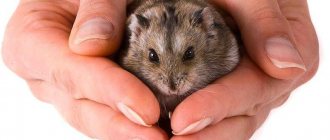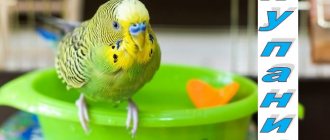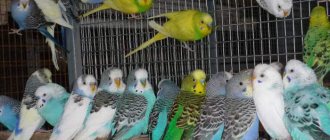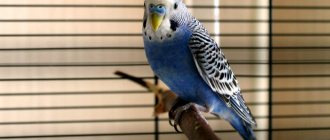When a feathered pet appears in the house, the owner is faced with the first difficulties: how to tame a budgerigar and how to help him adapt as quickly as possible. Taming an ornamental bird is a long process, but very interesting. If it is successful, the owner will not have problems with treatment, cleaning and other manipulations.
Wavys do not immediately go into a person’s hands. It takes more than one week to establish a trusting relationship: birds experience fear. What to do if a parrot is afraid, and how to overcome the psychological barrier?
How to train a bird
So, you brought your feathered friend from the store to his new home. What to do next to build a trusting relationship with him?
The process of training a parrot
Basic Rules
Is your parrot walking?
Not really
- An indispensable condition for taming any bird is frequent contact with humans. You need to set aside a certain time for classes, preferably in the morning before feeding. The recommended duration of training is at least 20-40 minutes per day.
- Discipline and training should begin as early as possible, while the bird is young. This will help establish control over your pet, especially after it reaches puberty, when rude teenage behavior is noted.
- In addition to age, the gender of the budgerigar is taken into account. For example, it is easier to teach a boy to speak than a girl.
- You need to understand the motives of the parrot's behavior and use only positive methods of encouragement: treats and praise.
- The owner must behave calmly and confidently. In the wild, parrots live in flocks with a leader. Your pet needs to be aware of what position he occupies in your family and who is in charge. Otherwise, the pet will constantly try to take a dominant position.
What questions should you ask before purchasing?
- how does he treat people, does he have fear of people?
- whether he has any health problems or physical disabilities
- what did they feed him?
- Are there any peculiarities in behavior?
- does he like to swim?
- Can he keep himself busy, for example, by enthusiastically playing with parrot toys?
- What was his daily routine, what time did he go to bed?
- Was he the only bird in the family, or were there always other birds next to him?
How long will it take
You won’t be able to quickly win over your feathered friend. You need to gain the bird's trust gradually, without putting pressure on it. It is difficult to name the exact time frame in which a parrot will become tame. They depend on how it was fed as a chick, whether there were previous contacts with humans, and whether the pet was ever afraid of people.
Of course, the owner's behavior is most important. Rough treatment will permanently undermine the bird's trust. Affection and care, on the contrary, will help you earn his love.
How long does it take to train a parrot?
What difficulties arise?
When taming the wavy, people often encounter certain difficulties.
These include:
- the bird refuses to contact a person, but even if the parrot is very afraid and behaves cautiously, constant communication leads to the desired results, so you need to patiently continue taming;
- if the pet does not want to contact, then you can install a toy in the cage with which the person will play with his hands, and a mirror also helps a lot, increasing the bird’s confidence;
- If at the very beginning the parrot flew out of the cage, you should not try to catch it and forcefully return it to its place, so it is best to wait for darkness, remember the location of the wavy, and then calmly pick it up and transfer it to the perch.
If you catch a bird in the light, it will frighten it very much, so it will be difficult to establish contact.
Step by step taming a budgerigar in your hands
Before teaching your wavy to talk or do tricks, it is advisable to teach your pet to sit on your finger. When a bird finds itself in your home for the first time, it is stressed. He will need about a week to adapt and get used to the new place.
After this, you can begin training, which is divided into the following stages:
- Eating delicacies in the presence of the owner.
- The bird lands on your hand.
- Staying outside the house and understanding the words: “Come to me!”
Adaptation to living conditions
First, the house with the pet is placed at human height. The room should be fairly quiet and light, and all irritants that could frighten the pet should be eliminated.
The parrot needs to adapt to a new place
You should not let him out of the cage in the first two weeks - in a panic, the parrot can get hurt or crash into something. Confused, he will not find his way back. And trying to catch the wind will make you a predator in his eyes and undermine trust for a long time.
When changing food and drink, or cleaning, approach the cage slowly and without sudden movements, calling your pet by name. Do this at the same time every day to make it easier for your bird to get used to it.
Upbringing
A wild parrot is at great risk when flying around the room. The pet must be able to fly on command to the owner's finger. It is easier to catch and examine a sick bird when it is easy to handle.
Large species of birds, unable to communicate with people, can pose a danger. Therefore, raising a parrot is a necessary condition for its maintenance.
First stage
The process of establishing contact will go faster and more efficiently if you prepare for it correctly. The purchased bird should be transported carefully, avoiding stress. You need to put fresh water and a feeder with food in the cage in advance. For a bird house, you should choose a place where there is no intensive movement of people, noise, or drafts. You can start training only after the pet has settled well in the new place and feels safe.
There are several rules that must be followed during adaptation. Near the cage with your pet you cannot:
- use a vacuum cleaner for cleaning;
- turn up the volume on the TV, radio, computer;
- move abruptly, shout, speak in a raised voice.
There is no need to stick your hand or finger into the cage to pet the parrot.
It’s not difficult to make sure that your pet has already settled into a new place. If the parrot does not become afraid when family members approach the cage, this indicates that the bird feels safe. A pet that has become comfortable in the presence of people calmly cleans its feathers and eats. But if he freezes when family members approach or tries to hide in a corner, the adaptation process is not yet complete.
It should be noted that young budgies under the age of 5-6 months are more amenable to taming. It is much more difficult to train an adult bird. It is advisable to buy pets from breeders. In a pet store, a parrot can be among its relatives for a long time, which significantly complicates the taming process.
Gaining trust
First of all, it is desirable to ensure that the pet pecks the grains from the hands and eats them in the presence of the owner. When he comes down to the feeder, approach carefully. At first the bird will get scared, fly up to the dome of the cage and start screaming.
Before training you need to gain the parrot's trust
But gradually her anxiety will decrease, the approach of a person will begin to be perceived calmly. Treat your little friend gently, without sudden movements or loud sounds. Place some treats in the feeder or on the perch.
The first stage of training is the longest. Once the person's approach no longer causes concern, begin offering treats from your hands, pushing them through the holes in the cage.
It will take multiple operations for the pet to gain courage, take the food and run away with it. Next time he will act more decisively, and one day he will stop walking away. The appearance of the owner is now associated with something good.
The next step of training is to let the wavy understand that his hand will be inserted into the cage. Carefully open the door, calling the pet by name, slowly place your palm with the treat inside, quietly and affectionately say the command: “Come to me!”
After several attempts, the pet will take the food and climb up to the perch with it. Some bird owners, to avoid being bitten, wear gloves during training. However, this measure may increase the bird's anxiety.
How can you gain trust from a parrot?
When letting your parrot roam around the room, check the windows, close the doors, and make sure other pets are isolated and the rest of the family is aware of the event.
Remove sharp objects, open containers with water, mirrors, and small parts that the bird can peck. Close the gaps through which the bird can fall behind a closet, sofa, or window sill.
First, the pet is carried out of the cage in your hand. If your feathered friend behaves calmly and does not fly away, it means that he has become completely tame and can learn to return to you when ordered.
If the parrot has successfully mastered everything, the time has come to establish a complete trusting relationship between you. Human-bird touch is an important part of your relationship.
Gently stroke the back of your pet's head through the openings of the cage. Over time, he will trust his owner so much that he himself will provide feathers for his favorite strokes.
You need to prepare the room before releasing your parrot
A parrot is considered completely tame when it allows itself to be picked up, scratched under its wings, or its feathers sorted without resistance. This means your pet is ready to learn tricks and have fun.
Feeding
You can earn the trust of your ward with the help of treats. Even wild birds can take a treat from human hands. When the pet is no longer nervous at the sight of a hand in a cage, you can proceed to the next stage - feeding, which allows you to teach your budgie to sit on your hand.
To begin with, you can stretch a piece of apple or carrot on a toothpick. It is acceptable to use other food that the bird especially likes. After a few days, you can offer food lying in the palm of your hand. To take it, the wavy will have to touch his finger with his paw. This point is very important. The owner needs to be very careful, otherwise the shy bird will become alarmed.
If such training is carried out regularly, then soon your pet will learn to climb onto a person’s palm in search of a treat. At this time, you can try to gently stroke your pet's tummy or back. Over time, he will climb onto your hand even without a treat.
On a note! This taming stage can take a long time. The transition to palm sometimes takes several weeks. Be patient.
Motivation with your favorite food
Rewarding desired behavior with tasty treats is the easiest way to train. Find out what your little friend likes to eat most, and only feed that food during training. It is important that it is safe for the pet. Bread, cookies, seeds or nuts are not suitable because consuming them in excess can be harmful to the birds. It is better to use pieces of fruits, vegetables, and berries for treats.
Acquaintance and adaptation
Changes in a bird's life, such as moving to a new owner, are always stressful. Like any living creature, a parrot needs time to accept them. It is normal for budgies to be afraid of new environments and people for the first 4-6 days.
In order for acquaintance and adaptation to be successful, it is necessary:
- give the bird enough time;
- take into account its characteristics (breed, character, health and age);
- act within certain rules;
- Communicate regularly with your pet, but do not impose.
During adaptation to a new home, it is better not to bother the bird. When the budgerigar gets comfortable in the cage, you can approach him for a short time and talk calmly.
Establishing communication with a little friend should occur on terms of mutual respect. You can't put your hands in the cage. A bird that is not accustomed to you will regard this as aggression.
Dance training: is it possible?
The parrot's ability to imitate human speech is widely known. But a talented pet can also be taught to dance. These birds really love music and are able to move rhythmically to the beat. There are several simple techniques for developing this skill.
Teaching a parrot to dance
- Correct selection of music. Play different songs for your pet, noting those to which he sings and moves with pleasure. The music should not be too loud or harsh, which could scare the bird. It is better to choose a cheerful, rhythmic and light melody.
- We help you feel the rhythm. If your feathered friend is in no hurry to start dancing, you can help him. Place the parrot on your finger or palm and walk around the room with it, swinging it smoothly and rhythmically to the beat of the song.
- Personal example. Smart feathered creatures imitate not only speech, but also human movements. Move your head to the music. Soon he will begin to repeat your actions.
- Encouragement. When teaching your pet any trick, it is important to treat him with a treat and praise him for the desired behavior.
Communication with a parrot outside the cage
Walking around the room and free flights are very important for the health of feathered friends. As a rule, it is not immediately possible to train budgies to get out of their usual house. These birds are very careful.
It is recommended to teach a parrot to leave its home as follows:
- open the door;
- move away 2–3 m and call your pet;
- show the bird a treat in your open palm and call it in a low voice.
The pet's first independent flights from the cage end in quick returns. The bird prefers to eat the obtained delicacy in a familiar environment. You can't blame her for this. Attempts should be repeated.
Soon the budgerigar will no longer be afraid of the room, and will deal with treats right in the palm of the owner. After a few more days, he will begin to fly out of the cage without food stimulation, and he will want to communicate with a person. Calm conversation, no sudden movements and affection will help you build your parrot's trust.
How to train a parrot to fly to you
If the bird allows itself to be taken out of the cage, then you can try to teach it to fly when its owner calls. For this, the parrot is released into the room. Call your pet by name and show him the treat, then command: “Come to me!” The bird, interested in the treat, will sit on the owner's finger.
A bad habit for birds is sitting on the shoulder. Large individuals are capable of causing serious injuries with their powerful beaks. A peace-loving pet can get tangled in hair, jewelry, and panic. In addition, a pet sitting on the shoulder perceives the owner not as a leader, but as an equal, which can cause problems with discipline.
A simple way to teach a parrot to fly into your arms
Features of habituation of a pair of birds
Some people prefer to buy a couple of parrots at once so that they do not feel lonely. But taming two wavy birds at once is much more difficult than one. The procedure is carried out in a standard way, so at first the birds are kept only in a cage. They get used to the presence of humans, and in the morning they should only be fed by hand.
Attention! It is forbidden to let untamed wavy birds out of the cage, as it is very difficult to catch them and force them to climb into the cage.
Since you have to work with two birds, the temperament and character of each individual are taken into account. Not all wavy animals are ready to learn together, so it is necessary to separate them for a while so that they get used to only a person.
It is also useful to read: How long do budgies hatch eggs?
What difficulties may arise
Difficulties associated with the age of the bird
period of youth
During puberty, the bird becomes aggressive towards its owner. It is important to have time to train your pet before this moment, otherwise its behavior will become uncontrollable.
If you have correctly established a hierarchy in which he occupies the lowest level, it will not be difficult to contain teenage outbursts of irritation.
With the onset of puberty, as well as proper nutrition, the pet can return to its previous peaceful state.
Mating season
Aggressive behavior can also be observed in an adult parrot during the breeding season. It occurs when a pet is too attached to one of the family members.
Mating season for a parrot
At this time, the parrot may attack members of the household out of jealousy. To avoid this, outside the mating season, accustom your pet to the company of other people. Let him sit on the finger of your loved ones and receive affection from them.
If your feathered friend mistakes your hand or household items for an individual of the opposite sex, and tries to court and mate with them, distract him. Place a new thing in the cage that will be interesting to study. In cases where the problem of sexual heat is too pronounced, it is worth getting a pair for your pet, or contacting a veterinarian for hormonal treatment.
Females may lay empty eggs multiple times during the breeding season. They cannot be removed, otherwise the bird will lay eggs again and again until it gets sick. After sitting on the nest for a while, the female will calm down and abandon the clutch herself.
Second stage of taming
Taming your pet and establishing quality contact will require patience. You can begin the second stage only after the bird begins to calmly and confidently approach the palm of the cage and peck all the grains. The next step is to slowly move your hand away. Gradually, the parrot will begin to sit on your palm without fear.
Now you can begin to accustom the bird to mastering its fingers. When the pet is in the palm of your hand, you need to slowly bend all your fingers and carefully bring your index finger closer to the bird’s paws. If she refuses to sit with you, you can lightly scratch the parrot’s belly, he will instantly understand what his owner wants from him.
Characteristics of the pet
Parrots are gregarious and social birds. They need constant communication with a person or their own kind. If your pet is left alone for a long time, he may become sad and get sick.
How to Tame a Parrot in Your Hands: Advice from a Veterinarian // Network of Veterinary Clinics BIO-VET
In this situation, problems appear in the behavior of the bird:
- loud and frequent screams;
- self-plucking feathers;
- bad habits.
It is very dangerous if the pet is left to its own devices during a walk. He damages furniture and wires, drops objects, gnaws indoor plants, and can hide and get stuck somewhere. The latter is especially true for females when they are looking for a secluded place for a nest.
Among other birds, the parrot is easier to tame. But this process cannot be forced. Initially, like any creature with a developed instinct of self-preservation, the pet is afraid of you and unfamiliar surroundings. Improper training can cause stress in the bird, constant aggression and mistrust towards people.
One of the common problems associated with mistakes in the education process is when a parrot bites. This happens when you have not yet explained your pet’s place in the family hierarchy, and he tries to take a leading position.
HOW TO EASILY TAME A PARROT | Arina Belaja
A parrot that is allowed to sit above human eye level already achieves the rank of leader. Don't show fear at such times. You can’t “ooh” loudly while withdrawing your hand.
You need to strictly say in a quiet, calm voice: “You can’t!” Then return the bird to the cage and completely ignore it for a while. Your pet will understand that such behavior is unacceptable.
What absolutely should not be done
It is strictly forbidden to do the following during training:
- Immediately climb into the cage, offering food from the palm of your hand;
- Without gaining trust, try to stroke;
- The use of force, coercion for contact, as a result the individual will begin to injure itself and show aggression;
- When bitten, scream and show negative emotions towards the pet;
- Do not wave your arms above his head; at the genetic level, parrots perceive movement above their head as danger;
- Clipping your wings, the procedure has a negative impact on the psyche.
By following important rules during the learning process, the result will be achieved. Even the most reserved bird will get used to its owner, will need communication and contact, the main thing is to be patient and regularly make careful attempts. If you liked the article or have something to add, then leave your comments and also join our VKontakte group.
What if there are several parrots?
If you have several birds, you may also encounter a number of problems. Although parrots are flocking birds, their relationships with each other are very different.
It’s worse when a pet has lived alone for a long time, and suddenly a relative is placed with him. A struggle for leadership begins, and fights break out. Even individuals of different sexes can behave aggressively towards each other.
What to do to minimize conflict behavior? Birds need to be introduced carefully and consistently. To begin, place two cages side by side for a few days.











